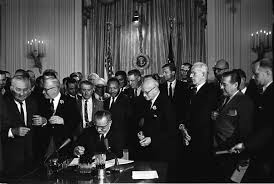Civil Rights Act Turns 50; Creating Cross-Racial Alliances
< < Go Back
By SHERYLL CASHIN,
THE Civil Rights Act of 1964, which banned discrimination in public accommodations, employment and federally funded activities like education, would not have passed without the support of House and Senate Republicans who were competing for black votes. And Presidents Kennedy and Johnson would not have advocated for the bill without being pressured to do so by a multiracial grass-roots movement.
The act became law on July 2, 1964. As we celebrate its 50th anniversary, we should pay close attention to the strange bedfellows behind its passage. Progressives today need to be just as overt at creating bipartisan, cross-racial coalitions that can win policy battles.
President Kennedy had been reluctant to press for a comprehensive civil rights bill. But when Bull Connor turned fire hoses and attack dogs on the children of Birmingham in the spring of 1963 and nearly a thousand nonviolent protests erupted in over a hundred Southern cities, suddenly doing nothing seemed more disastrous than alienating Southern Democrats. Kennedy began to work with moderate Republicans who wanted to give their party a pro-civil-rights slant.
There are important lessons here for progressives. Today most civil rights advocates focus on racial disparities, comparing the struggles of blacks and Latinos to those of whites without acknowledging that plenty of whites are harmed by the same structural barriers. Many whites shut down in the face of these arguments, rationalizing that minorities themselves are to blame and resenting the fact that their own economic pain is not being acknowledged.
Only 42 percent of Americans live in a middle-class neighborhood, down from 65 percent in 1970, a trend that limits access to quality schools and jobs for struggling people of all races. As awful and racially disparate as mass incarceration is, incarceration rates for black men have decreased since 2000 while they have risen for white men. A focus solely on black-white disparities masks the over-representation of high school dropouts of all colors in our prisons.
Instead, a civil-rights discourse that focuses on common challenges and values is needed to bridge the gaps between whites and nonwhites that contribute to toxic, partisan gridlock.
One example of the kind of policy that can be championed by cross-racial coalitions is the Texas 10 percent plan. It guarantees admission to a public college to graduates in the top 10 percent of every high school in the state. It was enacted in 1997, after a ruling against race-based affirmative action, with the support of blacks, Latinos and a Republican senator from rural West Texas, where some counties had never sent a student to the prestigious University of Texas at Austin.
In New Jersey, a similar coalition made up of local officials, faith leaders and engaged citizens, known as Building One New Jersey, has successfully backed state laws that stopped wealthy suburbs from buying their way out of affordable housing obligations and that mandated a more equitable allocation of school funding. Republican mayors from working-class towns allied with urban legislators from Camden, Trenton and Newark by having a forthright dialogue about how growing concentrations of minority poverty were destabilizing their neighborhoods and schools.
Another example is the Mississippi Immigrants Rights Alliance — a coalition of African-Americans, Latinos, unions and religious groups. In 2012, it helped create a swell of opposition to anti-immigrant legislation that made it easier for the conservative lieutenant governor, Tate Reeves, to buck Tea Party orthodoxy and assign the bill to a State Senate committee led by a Democrat he had appointed.
The only way for advocates of racial and economic equality to overcome partisan gridlock is through alliances with reachable whites, who often hew Republican. Such reconciliation could create a true politics of fairness, one that is worthy of the Civil Rights Act and the movement that made it possible.
More From The New York Times:




